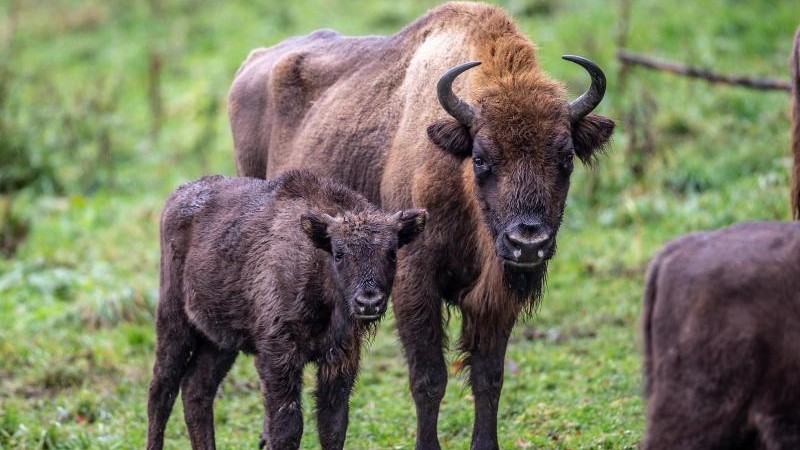Bad Berleburg (DPA) – Germany’s only herd of wild bison shows on this day what freedom means: none of the majestic giant cattle can be seen. Exactly at which point they are currently cruising through the Rothaargebirge is unknown.
“We haven’t had any contact for a few days. You’re in a valley where we can’t get a GPS signal,” says Henrik Brinkschulte, a bison keeper. “They live for free,” said the 24-year-old, shrugging his shoulders.
The future of the species protection project
At least still. The eight-headed herd was initially released into the wild in 2013. Eight years later, it remains to be seen how the species conservation project will proceed. Years ago, there was a legal dispute between some forest owners and the association sponsoring the project because bison in commercial forests nibbled on tree bark, which could cause trees to die.
More recently, the forest farmers who filed the lawsuit were right: They don’t have to accept bison entering their property and harming trees, according to the Ham Regional High Court ruling, which was not yet final.
Regardless of this, an opinion that has been commissioned by politicians but not yet published should help determine if or how the project can be continued. It’s also about the basics: who owns the forest which is not pure nature, but also timber production and is privately owned in North Rhine-Westphalia with a high 63 percent? How big is the wilderness in the most populous federal state?
Project Idea Background
There is no population density in the neighboring Rothaargebirge nor the neighboring Hochsauerlandkreis. There are the largest contiguous forest areas and the highest mountains in the country, and the road network is poor. As the region’s largest forest owner, Richard Prinz zu Sayn Wittgenstein-Berleburg had an idea in 2003 to bring the endangered species back to his area. Similar projects are usually found in Eastern Europe: the largest population of over 6,800 European bison lives in the wild according to the book The European Bison Herd in the Polish-Belarus Białowiega Forest.
“The launch projects have been and continue to be an important part of the conservation of key animal species, which enrich the local ecosystem,” explains Benjamin Blehel, a biogeographer at Humboldt University of Berlin. “A lot of people here don’t even know the animals exist,” says the wildlife expert. It is therefore quite desirable to release the bison in Central Europe – thus raising awareness.
Because bison were once home here – until humans hunted them and took their home. In the 20th century, the European bison, as the species is also known, became extinct in the wild. Only 54 animals survived in zoos and annexes at the time. In a study, Blehel and colleagues identified areas particularly suitable for the resettlement of wild mammals, including Moretz National Park and the Harz Mountains. The lowlands of the North Rhine-Westphalian mountain range are not among the preferred return areas. However: “This does not mean that the bison is not in good hands there,” the governor said.
Forage causes problems
He confirms that important pioneering work has been accomplished in the Rothar Mountains. It is possible for the bison to integrate more smoothly into other sites – for example where there are protected areas such as national parks. The herd has now grown to 24 or 25 animals. In search of forage, they tend to move leisurely—however, they have long since ceased to be in the area on their formerly intended Wittgensteiner land, and instead travel continually north in the Hochsauerland—to the annoyance of some forest farmers.
Because: A mature animal eats 40 to 60 kilograms a day — “everything that is green and juicy,” says Brinkshult, showing a piece of forest that the free-range herd had passed about four weeks ago. “Some of the beech trees were peeled off,” the guard says, pointing to a tree with a hole in the bark. In the event of such damage in the private forest, the sponsoring association compensates for it, its spokesperson assures. 50,000 euros is available annually in a fund for this purpose.
Wildlife director Kaja Heising, who is coordinating research on the project, prefers to talk about “impacts” rather than “damage” in terms of feeding marks on trees: “Bison shapes the landscape with their feeding behavior,” she says. Wherever it sinks to the ground, it creates so-called “micro-habitats”: small spaces are created where it allows more sun to grow new plants, and butterflies or lizards feel comfortable – a rich table with many birds.
The region also benefits economically from the prestige project, a whole branch of tourism for environmental education around the bison has emerged. She is convinced that the possibilities of coexistence between humans and bison can be explored. The project could also serve as a role model for species protection across Europe. “Isn’t it up to humans to find ways to live with the animal they once exterminated?” she asks.
© dpa-infocom, dpa: 211122-99-95112 / 2

“Alcohol buff. Troublemaker. Introvert. Student. Social media lover. Web ninja. Bacon fan. Reader.”






More Stories
“Time seems to cure long Covid.”
Science: The use of artificial intelligence is changing the way hospitals operate
Simple recipe: sweet cream cheese slices from the tray